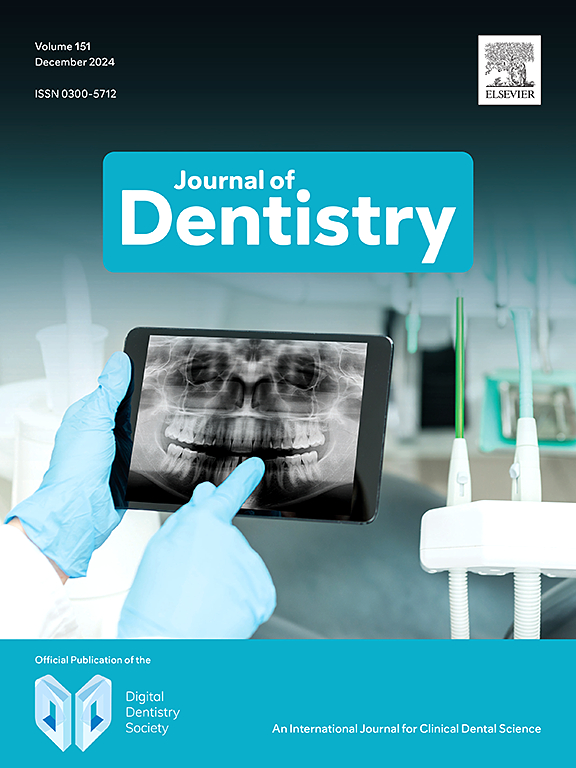Scan accuracy of recently introduced wireless intraoral scanners in different fixed partial denture situations
IF 4.8
2区 医学
Q1 DENTISTRY, ORAL SURGERY & MEDICINE
引用次数: 0
Abstract
Objective
To compare the in vitro scan accuracy (trueness and precision) of recently introduced wireless intraoral scanners (IOSs) to commonly used wired IOSs in different fixed partial denture (FPD) situations.
Methods
Three partially edentulous maxillary models with implants located at different sites (lateral incisors [Model 1]; right canine and first molar [Model 2]; right first premolar and first molar [Model 3]) were digitized with wireless (Primescan 2 [P2] and TRIOS 5 [T5]) and wired (Primescan [P1] and TRIOS 3 [T3]) IOSs (n = 14 per IOS-model pair). The models were also digitized with an industrial-grade optical scanner for their reference scans. The IOS scans were superimposed over the reference scans to evaluate the 3D distance, angular, and 2D interimplant distance deviations (trueness). The variance of measured deviations was defined as the precision and all data were analyzed with bootstrap analysis of variance and Holm-corrected Welch tests (α = 0.05).
Results
The IOS, FPD situation, and their interaction affected the scan accuracy (P < 0.001). P2 scans mostly had the highest and the scans of Model 2 mostly had the lowest 3D distance accuracy (P ≤ 0.030). P1 scans had the highest angular accuracy within each model, followed by the P2 scans in Models 1 and 2 (P ≤ 0.002). P1 scans mostly had higher 2D interimplant distance accuracy (P ≤ 0.047).
Conclusions
Digital impressions of tested FPD situations had high accuracy mostly with P1 and P2. The scans for a posterior 4-unit FPD might have higher inaccuracies, regardless of the tested IOSs.
最近引进的无线口内扫描仪在不同固定局部义齿情况下的扫描精度。
目的:比较新推出的无线口内扫描仪(IOSs)与常用的有线IOSs在不同固定局部义齿(FPD)情况下的体外扫描精度(正确率和精密度)。方法:三个部分无牙上颌模型,种植体位于不同部位(侧门牙[模型1];右犬齿和第一磨牙[模型2];使用无线(Primescan 2 [P2]和TRIOS 5 [T5])和有线(Primescan [P1]和TRIOS 3 [T3]) ios (n=14 /对ios模型)对右第一前磨牙和第一磨牙[Model 3])进行数字化。这些模型也被数字化,用工业级光学扫描仪作为参考扫描。将IOS扫描叠加在参考扫描上,评估3D距离、角度和2D种植体间距离偏差(真实度)。测量偏差的方差定义为精密度,所有数据采用自举方差分析和Holm-corrected Welch检验(α = 0.05)进行分析。结果:IOS、FPD情况及其相互作用影响扫描精度(P < 0.001)。P2扫描的三维距离精度最高,模型2扫描的三维距离精度最低(P≤0.030)。各模型中P1扫描的角度精度最高,其次是模型1和模型2中的P2扫描(P≤0.002)。P1扫描具有较高的二维种植间距离精度(P≤0.047)。结论:FPD测试情景的数字印象准确率较高,以P1和P2居多。无论测试的iss如何,后置4单元FPD的扫描可能有更高的不准确性。
本文章由计算机程序翻译,如有差异,请以英文原文为准。
求助全文
约1分钟内获得全文
求助全文
来源期刊

Journal of dentistry
医学-牙科与口腔外科
CiteScore
7.30
自引率
11.40%
发文量
349
审稿时长
35 days
期刊介绍:
The Journal of Dentistry has an open access mirror journal The Journal of Dentistry: X, sharing the same aims and scope, editorial team, submission system and rigorous peer review.
The Journal of Dentistry is the leading international dental journal within the field of Restorative Dentistry. Placing an emphasis on publishing novel and high-quality research papers, the Journal aims to influence the practice of dentistry at clinician, research, industry and policy-maker level on an international basis.
Topics covered include the management of dental disease, periodontology, endodontology, operative dentistry, fixed and removable prosthodontics, dental biomaterials science, long-term clinical trials including epidemiology and oral health, technology transfer of new scientific instrumentation or procedures, as well as clinically relevant oral biology and translational research.
The Journal of Dentistry will publish original scientific research papers including short communications. It is also interested in publishing review articles and leaders in themed areas which will be linked to new scientific research. Conference proceedings are also welcome and expressions of interest should be communicated to the Editor.
 求助内容:
求助内容: 应助结果提醒方式:
应助结果提醒方式:


